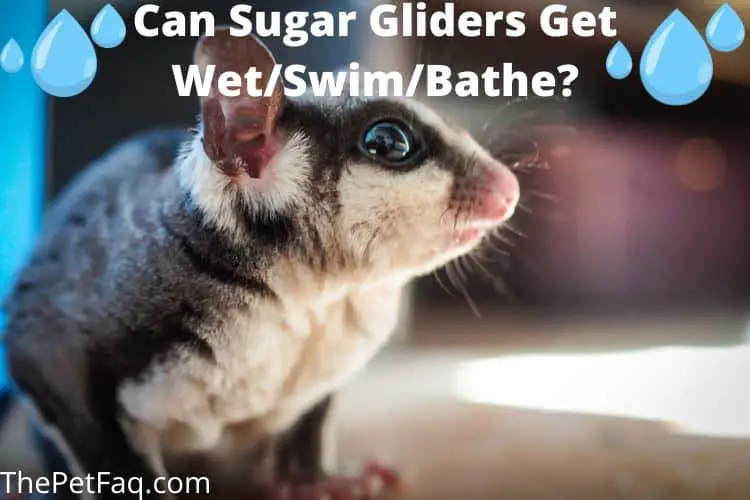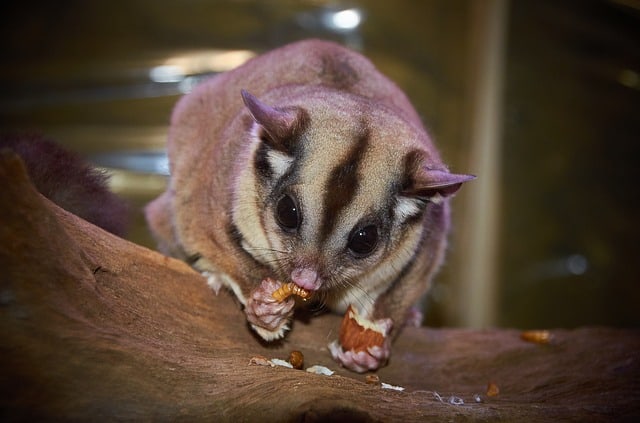The popularity of sugar gliders as pets has risen sharply throughout the years. It’s easy to see why, their adorable appearance along with their friendly nature makes them highly desired companions for many people, even though they’re quite difficult to care for. However, due to the fact that these are exotic animals, there’s quite a bit of uncertainty surrounding them. For instance, many people are curious whether sugar gliders can get wet, and by extension if they can swim or bathe.
If this is is something you’ve been curious about, you’ve come to the right place because today we’re going to go over everything you need to know about sugar gliders and water. Let’s dive in.

Can sugar gliders get wet?
You should avoid getting your pet sugar glider wet. The reason is not so much that the water is a threat to them, but more so that getting wet can lower their body temperature which can lead to hypothermia, illness, and even death.
Because getting wet is so dangerous for sugar gliders, it’s very important that you keep them away from open bodies of water. Do not play with them near a pool or bathtub or any place where they could possibly fall into the water.
Getting a little bit wet is not immediately a threat to them. After all, in nature, they get wet sometimes when it rains. It only becomes dangerous when they’re not dried off in time or if the water lowers their body temperature too much.
Can sugar gliders swim?
Sugar gliders are capable of swimming, but they’re not the best swimmers. They can swim to save themselves from drowning, but due to the fact that they’re arboreal creatures that live in the trees, they never really had a need to swim and tend to avoid being in the water.
As such, they do not enjoy swimming or being in the water and you should never take them for a swim. They will not enjoy it and it will be a highly stressful experience for them.
Can sugar gliders drown?
Yes, sugar gliders can drown. They are capable of swimming, but only for very short distances. They’re by no means natural swimmers and can drown quite easily, which is why it’s important that you make sure that you avoid putting them in the water.
Do sugar gliders need baths?
No, you do not need to bathe your sugar glider. The reason why this is not necessary is that they spend a lot of time grooming themselves and the members of their colony. Because of how much time they spend grooming, they’re always very clean and should not smell.
Giving them a bath is not only unnecessary, but it will also do more harm than good.
First, it will stress out your sugar glider. In the wild, they do not take baths, they tend to stay away from water, only going near it to drink. Because of that, being submerged in water is a stressful experience for them because they’re unfamiliar with it.
Secondly, bathing your glider gets rid of the natural oils that they have in their fur. These oils help keep them clean and help to keep their fur in good shape. Bathing them can get rid of these oils.
So, bathing your sugar glider is not something that you should do. However, you might run into a situation where your glider has something sticky or dirty stuck on their coat which they cannot remove through their regular grooming behavior. If that’s the case, you can take a damp, warm towel and rub the spot with it to clean them off. This should be sufficient to clean them.
Some people also believe that sugar gliders should take sand baths, but that’s not the case. Some animals such as chinchillas and hamsters take sand or dust baths, but that’s because they’re native to desert biomes. Sugar gliders are arboreal animals, they live in the forest. Because of that, they never take sand baths.

How to prevent getting your glider wet
Preventing your sugar glider from getting wet is luckily not all that difficult. The most important thing is that you keep them away from open bodies of water such as swimming pools, toilets, or bathtubs. That way, they cannot accidentally fall in.
Secondly, it’s important that if you have kids that will handle the glider you inform them that they should not get the animal wet. Children are inquisitive and might want to figure out for themselves whether a glider can swim or not while they’re playing with it. Avoid this by communicating the risks of a glider getting wet to them so that they know that the animal should stay dry.
What to do if your sugar glider gets wet
If your sugar glider gets wet accidentally, it’s important that you dry it off and keep it warm. That way, you can avoid undercooling which is dangerous to them. Make sure that you dry them off as soon as possible and that you bring them into a warm room so that the ambient temperature is warm enough.
However, one thing to avoid is putting direct heat on them. You might be tempted to dry them off by using a blowdryer, but that will heat them up too quickly, which is not good for them.
Final words
In the wild, sugar gliders are arboreal animals that live in forests. Because of that, they’re not very experienced swimmers. They’re capable of swimming to save themselves from drowning but they’re not great swimmers. Gliders also do not need baths, they groom themselves which is plenty to keep themselves clean. In fact, sugar gliders should not even get wet at all!
- How Long Do American Eskimo Dogs Live? Important Factors and Care Tips - September 29, 2023
- Do American Bulldogs Need Grooming? Essential Tips and Care Guidelines - September 29, 2023
- Do Bengal Cats Enjoy Playing? Essential Tips for Keeping Them Active - September 29, 2023